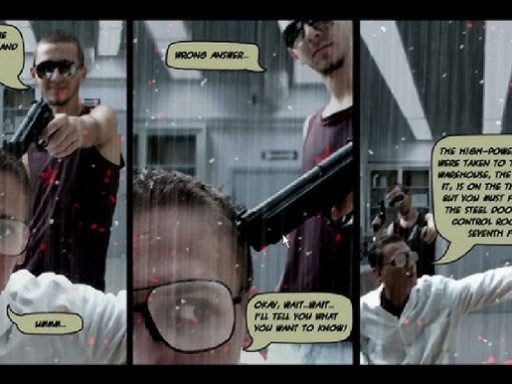Getting back into the workforce after a long break can be a little intimidating. The last time I actually applied for a job—was 2012, things were pretty different. These days, the job market feels like a whole new ballgame. From how CVs are written to automated systems filtering through applications, there’s a lot to learn and adjust to.
This article is based on my own experience of returning to the workforce. I’ll walk you through what I’ve learned, the mistakes I made, and the small wins that helped me move forward. Whether it’s fixing up your CV, handling rejections, or getting ready for interviews, I’ll share practical advice that might make the process a bit easier.
This isn’t just about getting a job—it’s about finding your footing again and feeling ready to take on something new. Let’s start from the beginning.
Updating Your CV for Today’s Job Market
The last time I used my CV to apply for a job was back in 2012. Back then, I had a simple Word document, which I’d save as a PDF and send out to recruiters.
I’ve prepared a version of my initial CV (below) for you, as an example.
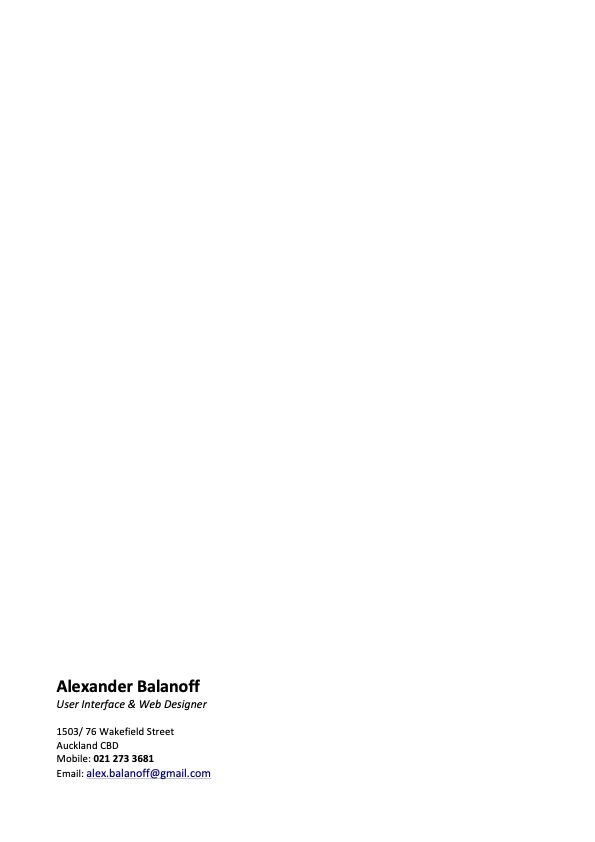


Fast forward to when I started re-entering the workforce recently, and I quickly realized just how much had changed.
First off, CVs have gotten shorter. In fact, they’re now expected to be concise—no more fluffy descriptions or long paragraphs. A modern CV needs to be clear, direct, and packed with only the most relevant information.
At first, I sent out my old CV as-is. It was a four-page document with my contact details on the first page and job experience spread out across the next few pages. I applied for around 40 positions, but to my surprise, I didn’t hear back from anyone—not even a rejection. It felt like I was sending my CV into a black hole.
That’s when a friend of mine offered some advice that seemed odd at first:
“Copy and paste the job description at the end of your cover letter, make the text invisible by setting the font size to 1px and the color to white.”
I thought it was a strange idea, but it turns out there’s a very valid reason for this.
Many recruiters use an applicant tracking system (ATS) to filter CVs. This system scans CVs for specific keywords from the job description, helping recruiters find candidates who match the role’s requirements. If your CV doesn’t contain these keywords, it could end up getting overlooked—no matter how qualified you are.
So, as you go through job postings, you’ll start to notice recurring keywords related to the tools, skills, and qualifications required for the position. Make sure your CV (and cover letter) include as many of these keywords as possible, but only if they’re genuinely relevant to your experience. It’s a way to ensure that your CV gets seen by the right people.
Here (below) is an example of my CV after condensing it to 4 pages.

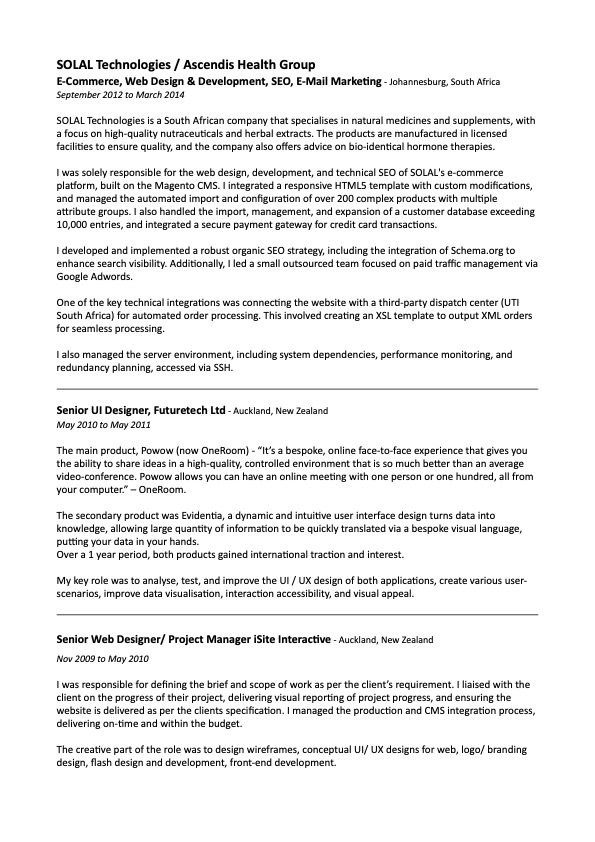
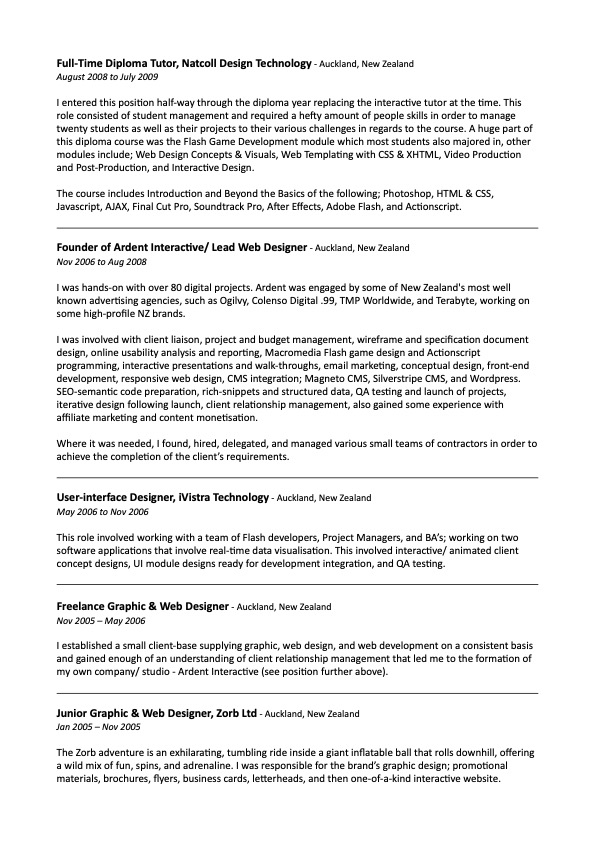
A/B Testing Your CV for Better Results
I thought, why not try do some user-testing, see which version of the CV performs better – at first, the idea of A/B testing my CV seemed unnecessary, but if you’ve ever worked with conversion rate optimization, you’ll understand why this makes sense. Recruiters don’t spend much time looking at each CV—they might glance at it for only a few seconds. So, it’s important that your CV grabs their attention right away with key information, especially relevant keywords.
I decided to test out a more streamlined and concise version of my CV. My original was four pages of text. After some browsing Canva’s collection of free CV templates, I found one that seemed to fit my needs for an A/B test.
A few hours later, I had a new, modern, slick, and concise CV—just two pages, with clear key points. I simplified my experience into bullet points, making it easier to read and focus on the most important details. Okay, okay… with a little help from Chat-GPT to fine-tune the language, my CV looked polished and professional.
I was so pleased with the result that I didn’t want to send out my old, text-heavy version anymore. Now, I was ready to see how this new CV would perform in the job market.


Writing a Cover Letter That Stands Out
Your cover letter is often the first thing a recruiter will see, so it’s important to make a good impression. Keep it clear and to the point—highlight what you’ve done, what you can do, and why you’re interested in the role. Be genuine and sincere.
One mistake you want to avoid is asking Chat-GPT to write your entire cover letter for you. While it’s okay to use it as a starting point, or for inspiration, recruiters can immediately tell when something has been generated by AI. It’s a red flag for them.
Instead, use Chat-GPT to help refine your ideas or suggest ways to phrase or paraphrase things, but make sure to personalize the letter. Tailor it to the job you’re applying for, and make it reflect your own voice. A unique cover letter that’s specific to the position will always stand out more than a generic one.
Since a cover letter is personalized for every application, I chose to work on this using Google Docs, and I selected the Business Letter template from the template gallery section.
I can easily modify the content, and export as a PDF.
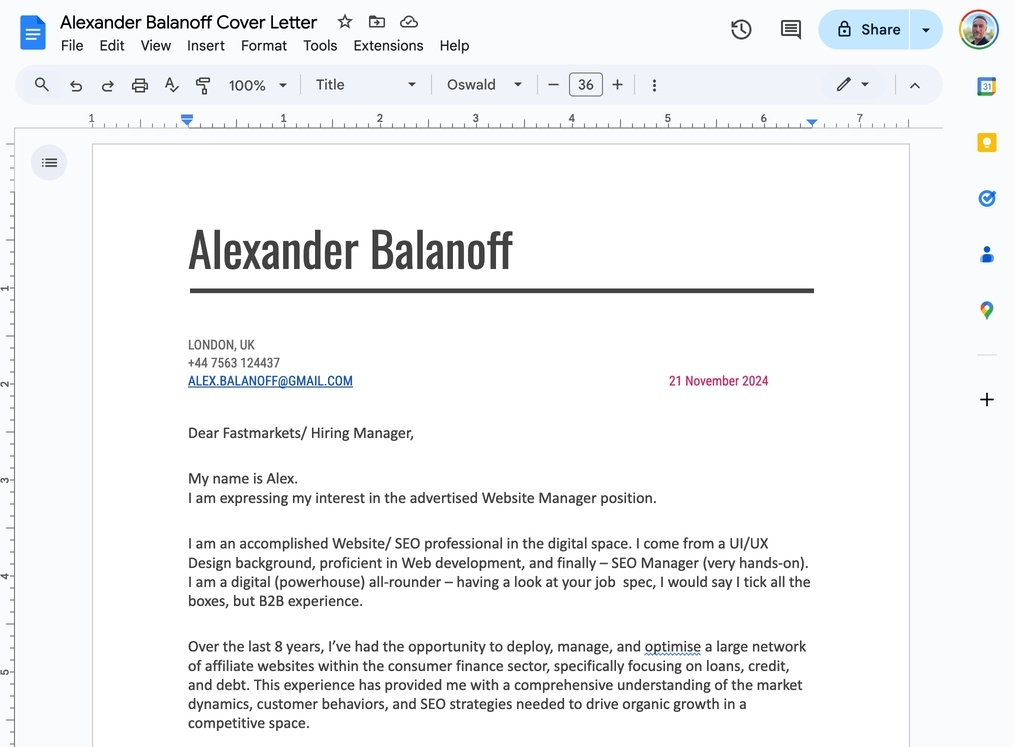
Handling Rejections Gracefully
Oh man, rejection can sting, especially when you feel like you’re the perfect candidate for a job. But I quickly realized that just because your qualifications check all the boxes doesn’t always mean you’re the right fit for the company or team. And let’s face it—nobody likes rejection. It’s something we all try to avoid.
Expect to face a lot of rejections. And here’s the kicker: many times, you won’t even get feedback on why you weren’t selected. It’s frustrating, but it’s just part of the process.
The best approach is to stay professional. Respond with something simple like, “Thank you for the opportunity, I appreciate your feedback.” and then move on. There are always more opportunities out there, and the right one will come along.
Don’t take it personally. I’m about 90 rejection emails deep, and still counting.
Preparing for Common Interview Questions
After submitting enough applications, you’ll eventually get that interview invitation. It’s exciting, but don’t get too comfortable just yet. Make sure you’re ready for the common interview questions. They may seem basic, even trivial, but don’t underestimate them.
Think through your answers in advance. Prepare a personal story or user scenario for each question that highlights your skills and experiences. The goal is to be ready, so you’re not scrambling for an answer on the spot. Being prepared will help you feel more confident and show the interviewer that you’re serious about the role.
12 common interview questions to help you get started
- Tell me about yourself.
- Why do you want to work for this company?
- What are your strengths and weaknesses?
- Why should we hire you?
- Tell me about a time you overcame a work challenge.
- Where do you see yourself in 5 years?
- Tell me about a time you worked in a team. What role did you play?
- How do you prioritize your work when you have multiple deadlines?
- Why did you leave your last job (or why are you looking to leave)?
- What do you know about our company and its culture?
- How do you handle stress or pressure?
- Do you have any questions for us?
Dressing Appropriately for Virtual and In-Person Interviews
Your first interview may be a brief phone call, but chances are, your next ones will be virtual or in person. Regardless of the format, it’s crucial to look presentable.
For virtual interviews, your appearance still matters. It’s easy to think that the camera only shows your upper half, so you don’t need to dress fully, but it’s better to be safe than sorry. Get a fresh haircut if needed, and trim your beard. Even though you’re not in the same room, looking neat and well-groomed shows you respect the process and the interviewer’s time.
When choosing your outfit, aim for smart casual. A collared shirt and a blazer are a safe bet. You want to look professional, but not overly formal. Keep your background tidy, too—make sure you’re not distracted by clutter or anything that could draw attention away from you. It’s all about making the best impression, even if you’re only seen from the waist up!
Prepare for Your In-Person Interview
In-person interviews come with a different set of expectations than virtual ones. You’ll need to focus on more than just your appearance—you’ll want to leave a strong impression through your body language and overall demeanor.
First, dress appropriately for the company’s culture. If you’re unsure about the dress code, it’s better to be slightly overdressed than underdressed. A smart outfit that’s both professional and comfortable will help you feel more confident. Think business casual—dress shirt and slacks or a nice blouse and trousers—but if you’re applying to a more formal role, you can opt for a full suit.
Arrive on time. This is non-negotiable. Arriving a few minutes early shows that you’re punctual and respectful of the interviewer’s time. If you’re unsure of the location, plan ahead and account for potential delays like traffic or parking.
When you’re in the room, maintain good posture. Sit up straight, make eye contact, and offer a firm handshake when you greet your interviewer. These small details help establish trust and convey confidence.
Lastly, remember to bring any materials you might need—extra copies of your resume, a list of references, and questions for the interviewer. A notepad and pen can be helpful for jotting down any important details or follow-up points.
Mastering Hiring Assessments & Tests
Competency tests, cognitive assessments, and problem-solving exercises are becoming a standard part of the hiring process—something that didn’t seem to be as common just a decade ago. If you’re like me, you might have been caught off guard by these tests when you re-entered the workforce. I had no idea what to expect and was surprised by the depth of some of the assessments.
These tests are designed to evaluate your cognitive abilities, logical reasoning, and how well you handle workplace scenarios. They may include things like situational judgment tests (SJT), numerical reasoning, verbal reasoning, and even skills-based simulations. The goal is to gauge your decision-making skills, your ability to solve problems, and how you approach challenges in real-time.
At first, I wasn’t thrilled about taking these tests, but the reality is they are part of the process now. I consider myself a good problem solver with strong technical skills, yet the first time I took a competency test, I scored 45%. It was a wake-up call, but I also realized that practice makes perfect. The more you familiarize yourself with these types of assessments, the better you’ll do.
The key to acing these tests is preparation. Start by doing some free online practice tests, like those offered by platforms such as Psychometric Success or Practice Aptitude Tests. These resources offer a range of free cognitive and competency tests that can help you get used to the format and types of questions you might encounter. Practice will improve your performance and boost your confidence.
Remember, part of your presentation during the interview is being well-prepared to handle these tests. It shows your potential employer that you’re willing to put in the effort to succeed.
Negotiating Your Salary and Benefits
Job hunting can feel like window shopping, but remember, it’s a two-way street. While the company is interviewing you, you’re also interviewing them. It’s not just about meeting their criteria—it’s about whether they also meet yours.
Before you accept an offer, take time to research the average salary for the role in your area. Know your worth, and don’t be afraid to ask for more if it aligns with your experience and market standards. Negotiation isn’t just about money—it’s also about benefits, work-life balance, growth opportunities, and the company culture.
Ask about flexible working hours, remote work options, or professional development opportunities if they matter to you. Approach the negotiation with confidence, ensuring the terms are fair for both parties. Don’t be tempted to simply accept the first offer—this is your career, and it’s important to make an informed decision that aligns with your needs and expectations.
Carefully Considering Job Offers
After all the hard work—applications, interviews, and assessments—you’ve received an offer. Before signing, take a moment to carefully assess it. If you have multiple offers, compare them side by side.
While salary is important, consider other factors like benefits, work-life balance, and growth potential. Does the company’s culture align with your values? Are there opportunities for advancement? Think about the long-term fit for your career.
If anything is unclear or negotiable, don’t hesitate to ask questions. Clarify job responsibilities, benefits, or probation periods. Trust your instincts—if something feels off, it might not be the right fit for you. Make sure the offer aligns with both your personal and professional goals.
Getting Ready for Your First Day
The big day is here! You’ve accepted the offer, and now it’s time to prepare for your new role. First, know what’s expected—dress code, client-facing duties, or remote setup. Make sure you have the right attire or technology in place, whether it’s a laptop, headset, or software access.
Plan your commute, so you know how long it will take to get to the office. If you’re remote, test your internet and video call setup in advance.
Consider the practical side—what will you wear on office days, and how will you handle lunches? Planning these small details will help you transition smoothly.
Starting a new job can be exciting and overwhelming, but being prepared helps you make a good impression and sets you up for long-term success.
In conclusion
Rejoining the workforce can feel like a daunting task, but with the right approach, you can take charge of the process and set yourself up for success. Stay persistent, be strategic, and most importantly, trust yourself. The road might have a few bumps along the way, but each step brings you closer to where you want to be.
Remember, every job is a stepping stone to something greater.
“The future depends on what you do today.” – Gandhi



